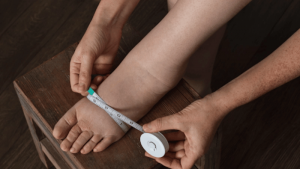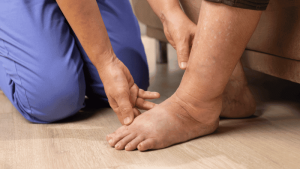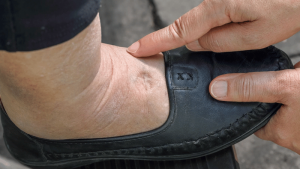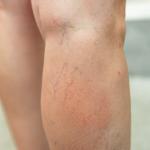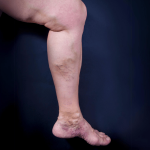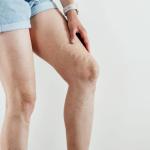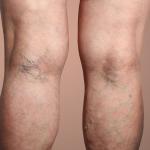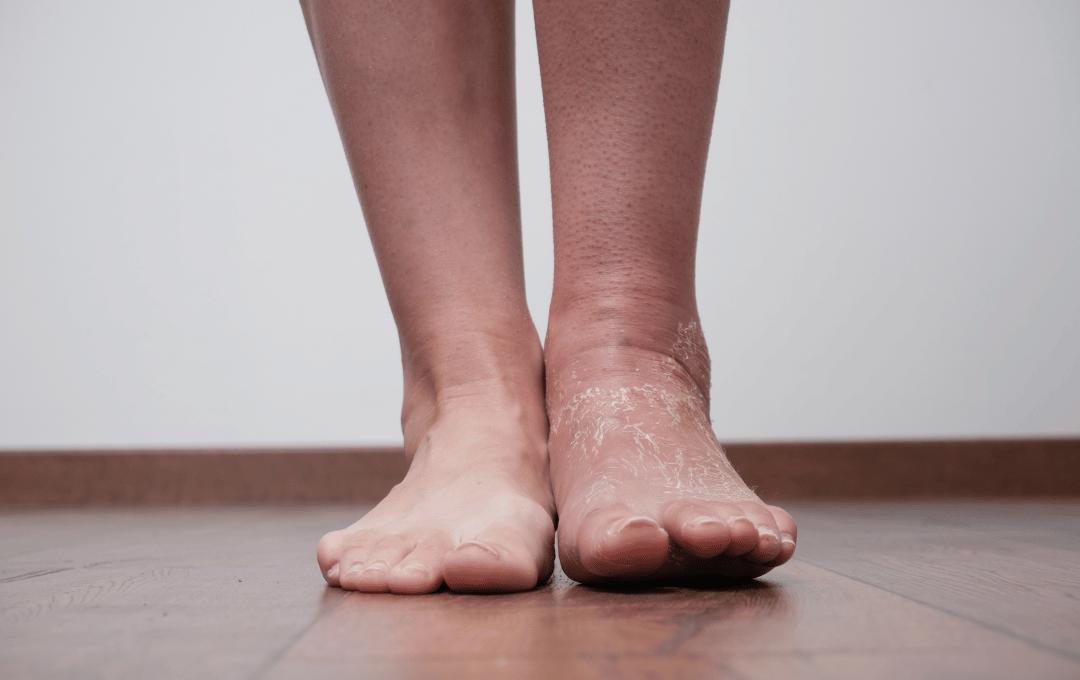
Experiencing swelling in one leg, also known as unilateral leg swelling, can be worrisome and should not be ignored. While occasional swelling might result from prolonged sitting, persistent or sudden swelling in one leg could signal an underlying medical issue.
Continue reading to discover more about potential causes, warning signs to watch for, and when to consult a specialist to help alleviate swelling in one leg.
When Should You Worry About Swelling in One Leg?
Swelling in one leg is usually a cause for concern because it can be a sign of a more serious health condition. While some causes of swelling in one leg, such as a sprained ankle, can be minor, others, like chronic venous insufficiency (CVI), require medical attention.
Swelling in one leg can also be a warning sign of a medical emergency, such as a blood clot, a weakening in the artery, or an infection. Knowing the causes and their associated symptoms can help you decide what to do if you notice one of your legs is swollen.
What Causes Swelling in One Leg Only?
Swelling in one or both legs can be caused by a range of conditions. Whether it’s the result of a vein condition, infection, or simply prolonged sitting or standing, it is important to understand the root cause to take the appropriate next steps.
Various reasons why you may experience swelling in one leg include:
- Chronic Venous Insufficiency or Vein Blockages: Chronic venous insufficiency (CVI) is a progressive condition that worsens over time, typically starting with the development of varicose and spider veins. You may notice leg pain, swelling, skin discoloration, and rashes. In severe cases, patients also develop venous ulcers and secondary lymphedema. This type of swelling can result from differences in blood flow, pressure, or the leg’s anatomy.
- Deep Vein Thrombosis (DVT): DVT occurs when a blood clot in a deep vein in your leg partially or completely blocks blood flow. This can lead to a build-up of fluid in the affected area, causing significant swelling in one leg. DVT should be treated as soon as possible to avoid pulmonary embolism.
- Lymphedema: Damage to the lymphatic system can also cause swelling. Lymphedema usually results from surgery, radiation, trauma, or a tumor, but can also be congenital. Lymphedema may also cause a feeling of heaviness or tightness, skin hardening, and a limited range of motion.
- Popliteal Artery Aneurysm: The popliteal artery is behind the knee, so experiencing severe pain and a visible bulge in this area are signs of a popliteal artery aneurysm. If it bursts, it can cause uncontrolled bleeding and swelling in the affected leg.
- Cellulitis: Cellulitis is a severe, potentially life-threatening, bacterial skin infection characterized by rapid swelling and intense pain. The affected area might also be tender to the touch. It can cause swelling in only one leg because it often originates from a break in the skin that lets bacteria enter and infect the surrounding tissue.
- Prolonged Sitting or Standing: Being sedentary can cause fluid to pool in the legs, leading to temporary swelling. For example, if you sit at a desk for four or more hours a day, changes in blood flow occur, causing fluid to accumulate. However, sitting or standing for too long usually affects both legs, so experiencing swelling in only one leg may be a sign of impaired blood circulation and underlying conditions like venous insufficiency.
- Minor Injury or Infection: Joint sprains, muscle strains, insect bites, and other minor injuries or infections can cause sudden, localized swelling in one leg. You may also experience redness or warm skin around the swelling.
Consult a vein specialist about any leg swelling, especially if it persists and occurs alongside other symptoms, such as pain, heaviness, or skin discoloration.
Why Is Only My Left Leg Swelling?
If you only have swelling in your left leg, you may wonder why that side is affected more than the right. While both legs can swell, the left leg is more commonly impacted due to specific anatomical and circulatory reasons.
One reason the left leg is swelling instead of the right is related to the structure of the veins in each leg. Both legs have similar vein structures, but academic journals noted there are slight variations in the left compared to the right, especially near the pelvic area.
Near the pelvis, there are the left and right iliac veins and arteries. The left iliac vein passes underneath the right iliac artery, and in cases such as May-Thurner syndrome (MTS), the right iliac artery compresses the left iliac vein. This compression impedes blood flow, adding pressure on the veins and causing the left leg to swell.
Types of Swelling
Swelling in one leg can fall into two main categories. The first is a pitting edema, which leaves an indentation when pressure is applied. It’s often associated with chronic venous insufficiency, heart failure, or fluid retention disorders.
The other type is non-pitting edema. It does not leave a dent when pressure is applied and is typically seen in cases such as lymphedema, thyroid dysfunction, or severe infections.
Left Leg Swelling Below the Knee: What to Know
Left leg swelling below the knee, such as in the ankle or calf, can signal chronic venous insufficiency (CVI). CVI develops when the valves in the lower leg veins weaken or become damaged, allowing blood to pool instead of flowing upward toward the heart. This pooling increases pressure in the veins, causing fluid to leak into surrounding tissues, resulting in swelling.
Common CVI symptoms include:
- Aching or heaviness in the leg
- Swelling that worsens after long periods of sitting or standing
- Itching or burning sensation
- Varicose veins
- Skin discoloration or changes in texture
- Restless legs or cramps at night
If you’re noticing these symptoms along with left leg swelling below the knee, visit a vein specialist, who can use medical imaging to determine what’s causing the swelling in the left leg.
Right Leg Swelling Only: What It Could Mean
Although the left leg is more commonly affected by certain conditions, such as May-Thurner syndrome, swelling in the right leg can also result from these conditions, as well as others.
Conditions that may cause right leg swelling include:
- Injury or trauma
- Infection or cellulitis
- Lymphedema
- Deep vein thrombosis (DVT)
- Aneurysm or other localized vascular issues
How to Reduce Leg Swelling
If you’re experiencing swelling in one leg or both, there are lifestyle changes and self-care tips you can implement in conjunction with targeted medical treatment to manage discomfort:
- Elevate your legs above heart level several times a day
- Wear graduated compression stockings to promote healthy blood flow
- Incorporate regular movement and walking to improve circulation
- Stay hydrated
- Reduce sodium intake to minimize fluid retention
While these tips help alleviate swelling, they do not address the underlying cause of vein disease. A vein specialist can help diagnose what may be causing swelling in your legs and recommend a treatment plan to manage your symptoms.
When to See a Vein Specialist for Swelling in One Leg
If you’ve noticed persistent swelling in just one leg, it could be a sign of underlying vein disease that requires medical attention.
You should see a vein specialist if you experience:
- Unilateral swelling
- Pain, redness, or warmth
- A history of varicose veins or CVI
- Risk factors for DVT
Schedule a Consultation with USA Vein Clinics Today
USA Vein Clinics’ team of experts provides comprehensive evaluations and minimally invasive vein treatments tailored to your condition. Our doctors can help you find relief and restore healthy circulation by addressing the underlying cause of leg swelling associated with vein disease, so you can quickly return to your routine.
Schedule a consultation at one of our nationwide clinics to eliminate unwanted symptoms and protect your health.
FAQs
Can Sitting Too Long Cause Swelling in Just One Leg?
Prolonged sitting typically leads to swelling in both legs because it increases pressure on the veins, causing blood to pool in the legs. However, when swelling occurs in just one leg, it often indicates a more specific issue, such as venous insufficiency or injury.
Does Heat Affect Swelling in One Leg?
Heat generally contributes to swelling in both legs (known as heat edema), not just one leg. If swelling is isolated to one leg, it might indicate a more serious issue that needs medical attention, such as deep vein thrombosis (DVT).
Can Varicose Veins Cause One-Sided Leg Swelling?
Varicose veins can lead to swelling in just one leg, which may be a sign of chronic venous insufficiency (CVI). While both legs can be affected, the swelling may be more noticeable on one side due to differences in vein structures between the legs or other underlying factors.

